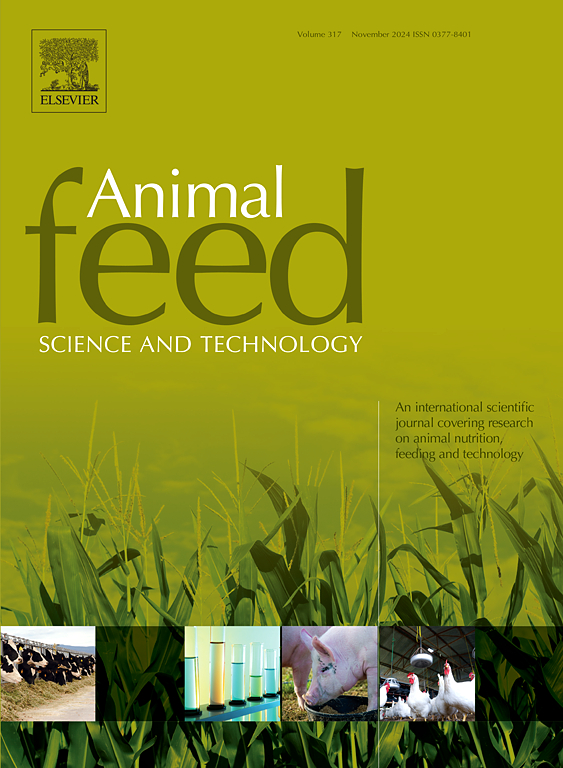Influence of fiber type on enteric methane production from growing-finishing pigs and subsequent biochemical methane potential of excreted feces
IF 2.5
2区 农林科学
Q1 AGRICULTURE, DAIRY & ANIMAL SCIENCE
引用次数: 0
Abstract
Three diets differing in type and amount of total fiber (TF) were formulated in order to investigate the effects of fiber type and amount on enteric methane (CH4) production from growing-finishing pigs and subsequent biochemical CH4 potential of the excreted feces. The experimental diets consisted of a control diet based on wheat, barley, and soybean meal, a diet with high content of insoluble TF based on wheat bran (WB), and a diet with high content of soluble TF based on sugar beet pulp (SBP). Eighteen female growing-finishing pigs were allocated to one of three experimental diets according to a replicated incomplete 3 * 2 Latin square design. After adaptation to the diet and metabolic cages, urine and feces samples were collected for 4 days, including 48 hours of gas exchange measurements in respiration chambers. Excreted feces were collected when pigs weighed 64.8 ± 3.8 kg and 89.7 ± 4.4 kg to determine the biochemical CH4 potential (BMP) of the feces in batch experiments. The enteric CH4 production expressed per TF intake was affected by the type of TF, with the lowest CH4 production obtained when pigs were fed a WB diet (P < 0.02). However, the decreased methanogenesis in the hindgut of the pigs was counteracted by the increased BMP90 of the feces. On the other hand, although feeding pigs with an SBP diet resulted in the highest enteric CH4 production, the CH4 derived from feces also remained high. In conclusion, the fiber type alters the methanogenesis in the hindgut of pigs and the subsequent BMP90 of the feces, and, therefore, needs to be considered during diet formulation in the context of minimizing enteric CH4 production and maximizing the BMP90 of the feces.
纤维类型对生长肥育猪肠道甲烷产量及随后粪便生化甲烷势的影响
为了研究不同纤维类型和添加量对生长育肥猪肠道甲烷(CH4)产量及粪便生化CH4势的影响,配制了3种不同纤维类型和添加量的饲粮。试验饲粮分为以小麦、大麦和豆粕为基础的对照饲粮、以麦麸为基础的高含量不溶性TF饲粮和以甜菜粕为基础的高含量可溶性TF饲粮。18头雌性生长肥育猪按重复不完全3 * 2拉丁方设计分别饲喂3种试验饲粮。适应饲粮和代谢笼后,收集4天尿液和粪便样本,包括48 小时呼吸室气体交换测量。收集猪体重为64.8 ± 3.8 kg和89.7 ± 4.4 kg时的粪便,进行批量实验,测定粪便生化CH4电位(BMP)。饲粮中每日粮所表达的肠道CH4产量受日粮类型的影响,其中WB组CH4产量最低(P <; 0.02)。然而,猪后肠产甲烷量的减少被粪便BMP90的增加所抵消。另一方面,尽管饲喂SBP日粮的猪肠道CH4产量最高,但粪便产生的CH4也保持在较高水平。综上所述,纤维类型改变了猪后肠的甲烷生成和随后的粪便BMP90,因此在日粮配制时需要考虑最小化肠道CH4产生和最大化粪便BMP90。
本文章由计算机程序翻译,如有差异,请以英文原文为准。
求助全文
约1分钟内获得全文
求助全文
来源期刊

Animal Feed Science and Technology
农林科学-奶制品与动物科学
CiteScore
6.00
自引率
6.20%
发文量
266
审稿时长
3 months
期刊介绍:
Animal Feed Science and Technology is a unique journal publishing scientific papers of international interest focusing on animal feeds and their feeding.
Papers describing research on feed for ruminants and non-ruminants, including poultry, horses, companion animals and aquatic animals, are welcome.
The journal covers the following areas:
Nutritive value of feeds (e.g., assessment, improvement)
Methods of conserving and processing feeds that affect their nutritional value
Agronomic and climatic factors influencing the nutritive value of feeds
Utilization of feeds and the improvement of such
Metabolic, production, reproduction and health responses, as well as potential environmental impacts, of diet inputs and feed technologies (e.g., feeds, feed additives, feed components, mycotoxins)
Mathematical models relating directly to animal-feed interactions
Analytical and experimental methods for feed evaluation
Environmental impacts of feed technologies in animal production.
 求助内容:
求助内容: 应助结果提醒方式:
应助结果提醒方式:


